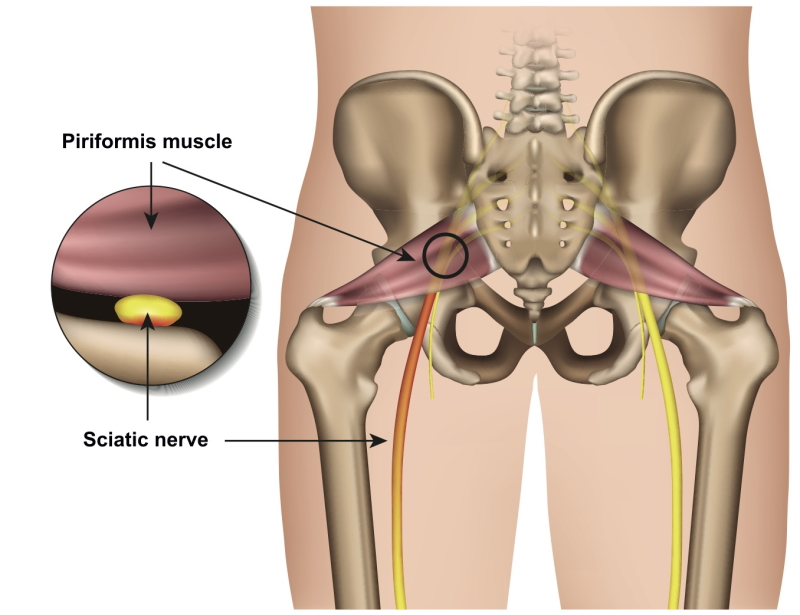Deep buttock pain, also known as deep gluteal syndrome, is common in active people. However, due to the complex anatomy of the buttocks, it can be challenging to pinpoint the exact cause of glute pain. So, what are the possible causes of deep buttock pain, and what are the steps to a correct diagnosis?
Buttock anatomy

Overall, the anatomy of the buttocks is complex.
Firstly, there are several muscles in this area. Superficially, the gluteus maximus and medius attach the pelvis to the thigh bone. Deeper, the gluteus minimus, piriformis, and other small hip rotators form the floor. Secondly, many nerves travel on top of these deeper muscles. The largest nerve is the sciatic nerve, which passes under the piriformis muscle to enter the upper thigh. In addition, the back of the hip joint lies under the buttock muscles, and the sacroiliac joint lies above and to the inside. Finally, the pelvic structures, such as the uterus, bladder, and prostate, sit deep in the buttocks, meaning pelvic problems can sometimes present with glute pain.
Common causes of deep buttock pain
Sacroiliac joint pain
The sacroiliac joints can cause buttock pain from arthritis or a fall directly onto the buttock. Generally, SI joint pain occurs in the upper part of the buttock near the spine. Ususally, the joint is tender to the touch, and specific SI joint examination tests are positive.
These joints are commonly affected by inflammatory arthritis, also called seronegative arthropathy.
Hamstring origin tendonitis causing deep buttock pain
The hamstring tendons attach to the pelvis sitting bone. Overload of the tendons can cause a high hamstring tendinopathy or proximal hamstring tendon tear.
Generally, high hamstring tendonitis pain is felt during sitting, driving, and running. Examination usually reveals a tender sitting bone and pain with hamstring exercises. Sometimes, swelling of the hamstring tendons leads to irritation of the sciatic nerve and thigh or lower pain.
High hamstring tendinopathy can be challenging and requires a dedicated treatment programme.
Sciatica – pinched nerve from the lumbar spine.
Pinching of the nerves in the lumbar spine can cause pain radiating into the leg, ankle, and foot. Sometimes, pinching nerve pain is solely in the buttocks. Usually, movement of the lower back produces pain in the buttocks. Other tests, such as the slump, are positive for pain in the buttocks.
Hip arthritis
Not many people realise that the back of the hip joint sits deep into the buttock muscles. Therefore, pain from hip arthritis can sometimes radiate to the buttocks. In general, moving the hip joint is painful and causes buttock pain.
Less common causes of deep buttock pain
Piriformis syndrome

The piriformis muscle sits across the top part of the buttock. The sciatic nerve passes under this muscle.
Piriformis syndrome describes pain from a tight piriformis muscle that traps the sciatic nerve. People usually report buttock pain that can move to the lower thigh. We use special tests to diagnose this condition.
Deep gluteal syndrome
The deep gluteal syndrome encompasses all causes of sciatic nerve trapping in the buttock. It includes piriformis syndrome and nerve trapping due to high hamstring origin tendinopathy or other muscles in the buttock.
Ischiofemoral impingement
Ischiofemoral impingement is the pinching of the quadratus femoris muscle between the pelvic and upper thigh bones.
It is a rare cause of deep gluteal syndrome. Generally, we diagnose it using an MRI, which shows swelling in the quadratus femoris muscle.
Pudendal nerve entrapment
The pudendal nerve supplies the skin near the anal passage. It is close to the sitting part of the pelvis (also called the ischial tuberosity).
Pain from pudendal nerve trapping presents as lower buttock pain, radiating into the inner groin, outer anal passage or genitalia.
It is a rare cause of buttock pain. Generally, consider pudendal nerve trapping if other causes of gluteal pain are ruled out.
How to make a diagnosis of deep buttock pain
An assessment is essential to diagnose deep buttock and hip pain.
Firstly, a history of pain location and characteristics gives clues to a diagnosis. For example, sitting or driving pain suggests hamstring tendonitis, while pain with walking is more likely ischiofemoral impingement. Examining the different parts of the buttocks and spine will also help make a diagnosis. Moreover, we perform special tests on the sacroiliac joint, hip joint, and hamstring tendon.
Usually, imaging helps to confirm a diagnosis. For example, an X-ray and ultrasound can show hip, sacroiliac joint, and pelvic tendons changes. However, a good-quality MRI scan is the most helpful test for diagnosing gluteal pain. Sometimes, nerve studies can assist in determining whether the pain is coming from the spine or the buttocks.
Generally, treatment depends on the cause. However, we recommend simple therapies such as physiotherapy, medication, and injections regardless of the pain’s origin.
Injections can confirm a diagnosis and help treat pain. We can use cortisone, PRP, or nerve blocks. Targets for injections include the hip joint, sacroiliac joint, hamstring origin tendon, piriformis muscle, and trochanteric bursitis.
Finally, surgery should only be considered if all other treatments fail. Surgery has the added risks of infection and worsening pain after intervention.
Final word from Sportdoctorlondon on deep buttock pain
Deep buttock pain is complex. You should see an experienced sports doctor who can find a cause and point you in the right direction for effective treatment. Surgery should be avoided in almost all cases.



Hi, do you carry out investigations into trigger point pain referred into the gluteal muscles? Also do you carry out trigger point injections? Thanks.
Hi Anne, I used to perform trigger point injections when I trained in Australia. But now I rarely do them. However, for non-specific buttock pain, I think trigger point injections could be useful in some cases. Lorenzo
Hello
Had butt pain since fall in 2018
Nobody has got to the (pardon the pun) bottom if it
Been diagnosed hesitantly by specialist with arthritis.
I have always believed i damaged my Piriformis, but no doctors or specialist wanted to listen.
Hi Mike, yes, buttock pain can be complex. Sometimes injections can help with diagnosis and therapy. LM
I can’t sit on my butt. My right buttocks literally feel like it slide into my anus. I feel like I’m sitting on a balloon half filled. It causes radiating pain in my butt and the skin. I had necrosis of right hip and hip was replaced and I still need to get the left hip done. What could be causing this? I’m very depressed. I
You might have nerve damage : https://sportdoctorlondon.com/overview-of-groin-nerve-pain/
Of course, you need to speak to your MSK doctor.
Hi, I have buttlock pain for 50 days now I did an x ray and some blood tests didn’t find anything, in the beginning the pain was on both sides now I can say it is concentrated on one side, when I sit more that 1 hour I start feeling it, not an acute pain but enough to recognize it, do I need an MRI what this might be
Hi Abdel,
I definitely recommend an MRI scan – if you have sitting pain, hamstring origin tendonitis is a possibility
https://sportdoctorlondon.com/high-hamstring-tendinopathy/
Other possibilities include sacroiliac joint pain
https://sportdoctorlondon.com/sacroiliac-joint-injection/
Lorenzo